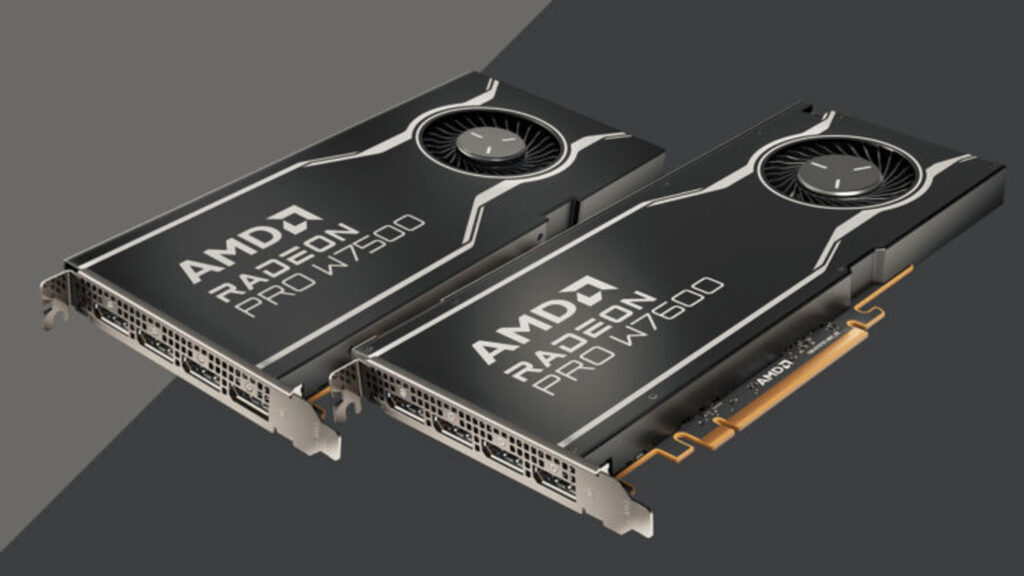AMD targets volume mid-range segment with new RDNA 3 pro graphics cards
AMD has launched the Radeon Pro W7600 and Radeon Pro W7500, a duo of ‘mid-range’ desktop pro workstation GPUs built on its RDNA 3 architecture.
The new graphics cards are designed to target ‘medium’ workloads for 3D CAD, visualisation, video editing, and digital content creation. They follow on from the ‘ultra-high-end’ AMD Radeon Pro W7800 and W7900 which launched earlier this year (read our review).
The Radeon Pro W7600 and W7500 are both full height, single slot GPUs, so are designed to fit in standard desktop tower workstations and not small form factors (SFFs) / ultra-compacts.
In terms of their performance profiles and price, the new GPUs seem well positioned. However, it feels like AMD could be limiting their potential reach by not giving at least one of them a low-profile form factor, which rules them out of SFF and ultra-compact workstations.
Both GPUs come with 8 GB of GDDR6 memory and four DisplayPort 2.1 Connectors, the latest version of the digital display standard. According to AMD, this means the cards are future proofed for next gen displays in terms of refresh rate, pixel resolution and colour bit-depth.
The Radeon Pro W7500 offers 12.2 TLOPs of peak single precision performance and has a total board power of 70W, so can operate with PCIe slot power alone. It costs $429.
The Radeon Pro W7600 offers 19.9 TLOPs of peak single precision performance and has a total board power of 130W, so needs a 6-pin connector. It costs $599.
Both GPUs comprise multiple unified RDNA 3 compute units (28 on the W7500 and 32 on the W7600). Each compute unit has 64 dual issue stream processors, two AI accelerators and a second gen ray tracing (RT) accelerator. According to AMD, RDNA 3 offers up to 50% more raytracing performance per compute unit than the previous generation.
There is growing software compatibility for AMD RT accelerators. In addition to DirectX Raytracing (DXR) and Vulkan ray tracing, for which there is direct support, AMD’s open-source toolset HIP, is helping software developers automatically translate their existing Nvidia CUDA code bases.
In terms of the competition, AMD compares the AMD Radeon Pro W7600 to the similarly priced Nvidia RTX A2000 (12 GB) and the AMD Radeon Pro 7500 to the Nvidia RTX T1000 (8GB). The company claims better performance in CAD applications Solidworks and PTC Creo and the AEC-focused real time viz tool Twinmotion. Both Nvidia GPUs are available at similar price points, but the Nvidia GPUs are compatible with both standard towers and SFF / compact workstations.
What DEVELOP3D thinks
The roll out of AMD’s new generation RDNA 3-based pro GPUs comes straight out of the workstation graphics playbook. Start at the high-end and then move down the range.
With the new Radeon Pro W7500 and W7600 AMD is looking to target a specific part of the workstation market – the mid-range $350 to $950 dollar segment, which it describes as the largest piece of the pie.
In terms of their performance profiles and price, the new GPUs seem well positioned. However, it feels like AMD could be limiting their potential reach by not giving at least one of them a low-profile form factor. Small Form Factor and ultra-compact workstations, such as the HP Z2 Mini and Lenovo ThinkStation P3 Ultra, represent an increasingly big slice of the mainstream workstation market, not just on desktops but in racks for remote graphics deployments.
AMD could be choosing to focus more on getting these pro GPUs out in the market via specialist system builders, such as Armari and BOXX, who tend to only sell tower workstations.
Alternatively, perhaps AMD feels there is less need for a low-profile form factor pro GPU going forward. As Jimmy Holbert, director of Radeon Creator & workstation strategy at AMD pointed out in the press briefing, AMD’s APUs (CPUs with integrated GPUs) are starting to have an impact in the entry level pro GPU market. With rumours of much beefier models coming next year, could AMD plan to extend the reach of its APUs into the mid-range?
In addition, by configuring both of the new GPUs with 8 GB of memory, it looks like AMD could be limiting where these cards can be used. While 8 GB is currently sufficient for most CAD and BIM workflows, many real time visualisation or GPU rendering tools can easily use more memory, especially at higher resolutions. And that’s without considering multi-tasking workflows, where an architect might model in Revit and render in the background with Lumion or Twinmotion.
Look out for a full review soon.






